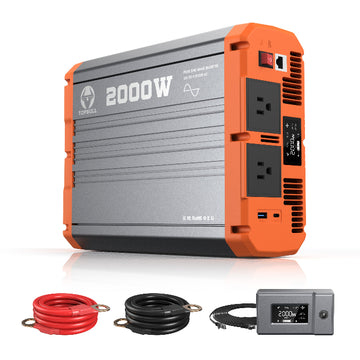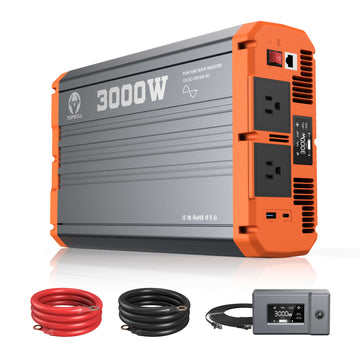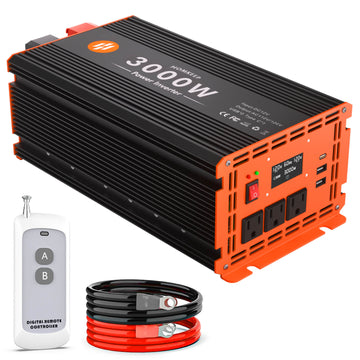Whether it's for home backup power, RV travel, or outdoor camping, the 1000W inverter is a common choice for power needs. If you decide to purchase one, you may wonder: What devices can it support? Are there any hidden limitations? More importantly, is it right for my needs? This article will give you the answers.
What devices can a 1000W inverter power?
The 1000W inverter can power a wide range of small to medium power devices, but it must leave a 20% safety margin (i.e., no more than 800W continuous load).
Electronic devices: LED TVs (50-150W), laptops (20-100W), routers (5-15W), cell phone/tablet chargers (5-20W), and more. The power required to run these devices is much less than 1000W, and the inverter can power multiple electronic devices at the same time.
Lighting, Fans: During a power outage, the 1000W inverter can support multiple LED light bulbs and fans at the same time. LED lights are more energy efficient than incandescent bulbs, typically consuming no more than 20W.
Office equipment: desktop computers (200-400W), laser printers (starting power 800-1000W), even if the power outage can let you work at ease.
Kitchen appliances: Coffee maker (600-800W), small microwave (700W), slow cooker (200-300W), mini fridge (500W starting power, 100-200W running power). A 1000W inverter can support powering some low-power kitchen appliances while camping, but simultaneous use should be strictly avoided.
Power tools: drills (500-800W), angle grinders (750-1000W). Most power tools have a high surge power, and the equipment wattage must be checked strictly to avoid exceeding the limits of the inverter.
Key considerations
- Starting power: Motorized equipment (e.g., refrigerators, drills) may require 2-3 times the operating power to start, so make sure the inverter surge power can be covered.
- Waveform compatibility: Corrective waveform inverters can cause overheating or damage to sensitive equipment; always choose pure sine wave for medical equipment and precision electronics.
- Stacking risk: Do not exceed the 1000W continuous power rating when connecting equipment. When running multiple devices, prioritize based on power demand. If too many devices are running and exceed 1000W, the system will immediately overload and cut off power.
Limitations of the 1000W inverter
1. Waveform
Not every 1000W inverter is flexible enough to perform in small to medium power scenarios, and its practical application range is also limited by its waveform. There are two common types of inverters: pure sine wave inverters and modified sine wave inverters.

The output waveform of a pure sine wave inverter is identical to the mains and is suitable for almost all devices. Do I have to buy a pure sine wave inverter? The answer is no. From the cost point of view, the price of a pure sine wave inverter is 40%-60% higher than the corrected waveform. If it is only used for basic equipment (e.g., lighting, charging), the advantages cannot be reflected, and the price-performance ratio is low.
However, you must use a pure sine wave inverter to drive the following devices:
- Medical equipment: CPAP ventilator, oxygen generator, infusion pump, dialysis machine
- Household precision appliances: microwave ovens, refrigerators, printers, scanners
- Entertainment systems: game consoles, high-end audio, recording equipment, OLED TVs, monitors
- Motorized tools: brushless drills, angle grinders, intelligent floor sweeping robots
Modified sine wave inverters cost less but are not friendly to sensitive equipment. If you are on a budget and only need to run simple equipment, consider this option.
The following devices are suitable for modified sine wave inverters:
- Resistive loads: incandescent light bulbs, electric blankets, electric heating pads, electric ovens, toasters
- Basic power tools: electric drills (brushed motor models), handheld vacuum cleaners (mechanical switch models)
- Low-sensitivity electronics: electric fans (mechanical speed models), non-inverter chargers, old CRT televisions
-
Simple emergency equipment: car inflatable pump, electric mosquito repellent, campsite lighting (halogen lamps)
2. Power limitation
The 1000W inverter is not capable of driving high-power equipment such as large refrigerators, air conditioners, welding machines, etc. The actual safe load of the 1000W inverter is 800W. If the continuous load exceeds 800W, the internal temperature of the inverter will rise about 3-5℃ per minute, and the overheating protection may be triggered to force the inverter to shut down within 10 minutes.
Is a 1000W inverter right for me?
Whether a 1000W inverter is right for you depends on your power needs. The core principle of choosing an inverter is to match it to your needs. An inverter with too little power may render the equipment inoperable, while too much power is a waste of cost and reduces efficiency. Here's how to determine if a 1000W inverter is right for you:
Define your power scenario
The 1000 Watt Inverter is an excellent choice for those looking to power small devices and appliances while on the go. Whether you're camping, working outdoors, or experiencing a power outage, the 1000 Watt Inverter can accommodate a variety of small appliances and lighting needs.
Calculating total equipment power requirements
It is important to know the power requirements of your equipment and ensure that you do not exceed the limits of your inverter. You can make a list of the equipment required, and the power rating will be documented on the label or manual for each device. It is important to note that some devices will have a surge power greater than the rated power.
Required power for inverter ≥ (equipment operating power × 1.2 surge factor + other equipment operating power) × 1.2 safety margin
Use a larger inverter if you want to run high-power equipment or need longer run times.
How long will the 1000W inverter run?
The time the 1000W inverter runs is determined by a combination of battery capacity, device power, and system efficiency.
- Battery capacity (Ah): The available capacity of lead-acid batteries is usually 50% of the nominal value. The lithium battery, which is popular for its high energy utilization rate, has a usable capacity of 80-90%, and the 500Ah lithium battery has a usable capacity of 400Ah.
- Battery voltage (V): The voltage of the inverter must be matched with the battery; too high or too low a voltage will damage the equipment.
- Inverter efficiency: Pure sine wave inverter conversion efficiency is about 85-90%, correction wave is 75-85%, and loss is dissipated in the form of heat.
- Total power of the equipment (W): The sum of the power of all the equipment running at the same time needs to be calculated and must not exceed the safe load of the inverter (800W).
Running time (hours) = (Battery capacity (Ah) × Battery voltage (V) × Depth of discharge (DOD) × Inverter efficiency) ÷ Total power of the device (W)
Example: running 300W device with 12V 100Ah Li-ion battery (DOD=80%) and 1000W pure sine wave inverter (90% efficiency)
Running time: (100Ah × 12V × 0.8 × 0.9) ÷ 300W = (864Wh) ÷ 300W ≈ 2.88 hours
In practical applications, the inverter runtime is also affected by power fluctuations and ambient temperature.

FAQ
Q: Can a 1000w inverter run an air conditioner
A: No. The power of common air conditioners on the market is generally 500-1000W; even the lowest power air conditioner, the moment the compressor starts, the surge power can reach 1500W. The safe load limit of the 1000W inverter is 800W. Running an air conditioner requires a larger inverter, such as 2000Wa pure sine inverter
Q: Can a 1000w inverter run a refrigerator?
A: Whether the 1000W inverter can run a refrigerator depends on the type of refrigerator. The 1000W inverter can support some low-power refrigerators, but it needs to match the power parameters strictly. For air conditioners with no starting surge or starting surge less than 800, the inverter can run. However, it should be noted that they should not use too many devices at the same time.
Q: Can a car run a 1000W inverter?
A: Yes, most car batteries do not exceed 100A. they can usually support an inverter of about 1000W. However, care must be taken with the duration of use, overuse may cause damage to the car battery.












